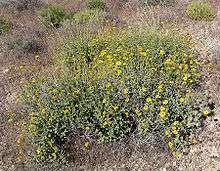Encelia virginensis
| Encelia virginensis | |
|---|---|
 | |
| Scientific classification | |
| Kingdom: | Plantae |
| (unranked): | Angiosperms |
| (unranked): | Eudicots |
| (unranked): | Asterids |
| Order: | Asterales |
| Family: | Asteraceae |
| Tribe: | Heliantheae |
| Genus: | Encelia |
| Species: | E. virginensis |
| Binomial name | |
| Encelia virginensis A.Nels. | |
| Synonyms[1] | |
| |
Encelia virginensis is a North American species of flowering plants in the daisy family known by the common name Virgin River brittlebush. This shrub is native to the southwestern United States and northwestern Mexico, particularly the Mojave Desert and the Sonoran Desert. It has been found in Baja California, southern California, Nevada, Arizona, southwestern Utah, and southwestern New Mexico.[2]
Encelia virginensis is a bushy, sprawling shrub reaching heights between 100–150 cm (40-60 inches). It has many branches, with the younger parts hairy and the older stems developing a thickened bark. The gray-green, fuzzy to hairy foliage may be sparse, appearing pale because of the presence of many small hairs on the surface. Atop many erect, hairy stems are solitary daisy-like flower heads with 11 to 21 ray florets which are generally yellow, and a center of yellow disc florets. The fruit is an achene 5 to 8 millimeters long and usually lacking a pappus.[3][4]
- Varieties
- Encelia virginensis var. actonii (Elmer) B.L.Turner - California, Nevada, Baja California[5][6][7]
- Encelia virginensis var. virginensis - southern California, Nevada, Arizona, southwestern Utah, and southwestern New Mexico[2][8]
References
- ↑ The Plant List Encelia actoni Elmer
- 1 2 Biota of North America Program 2014 county distribution map, Encelia virginensis
- ↑ Flora of North America, Encelia virginensis A. Nelson
- ↑ Nelson, Aven 1904. Botanical Gazette 37(4): 272–273
- ↑ Biota of North America Program 2014 county distribution map, Encelia actoni
- ↑ Calflora taxon report, University of California, Encelia actoni Elmer, Acton brittlebush
- ↑ Flora of North America, Encelia actoni Elmer
- ↑ Calflora taxon report, University of California, Encelia virginensis Nelson, Virgin River brittlebush
External links
 Media related to Encelia virginensis at Wikimedia Commons
Media related to Encelia virginensis at Wikimedia Commons- Jepson Manual Treatment of Encelia virginensis
- United States Department of Agriculture Plants Profile for Encelia virginensis (Virgin River brittlebush)
- Encelia virginensis — Calphotos Photo gallery, University of California